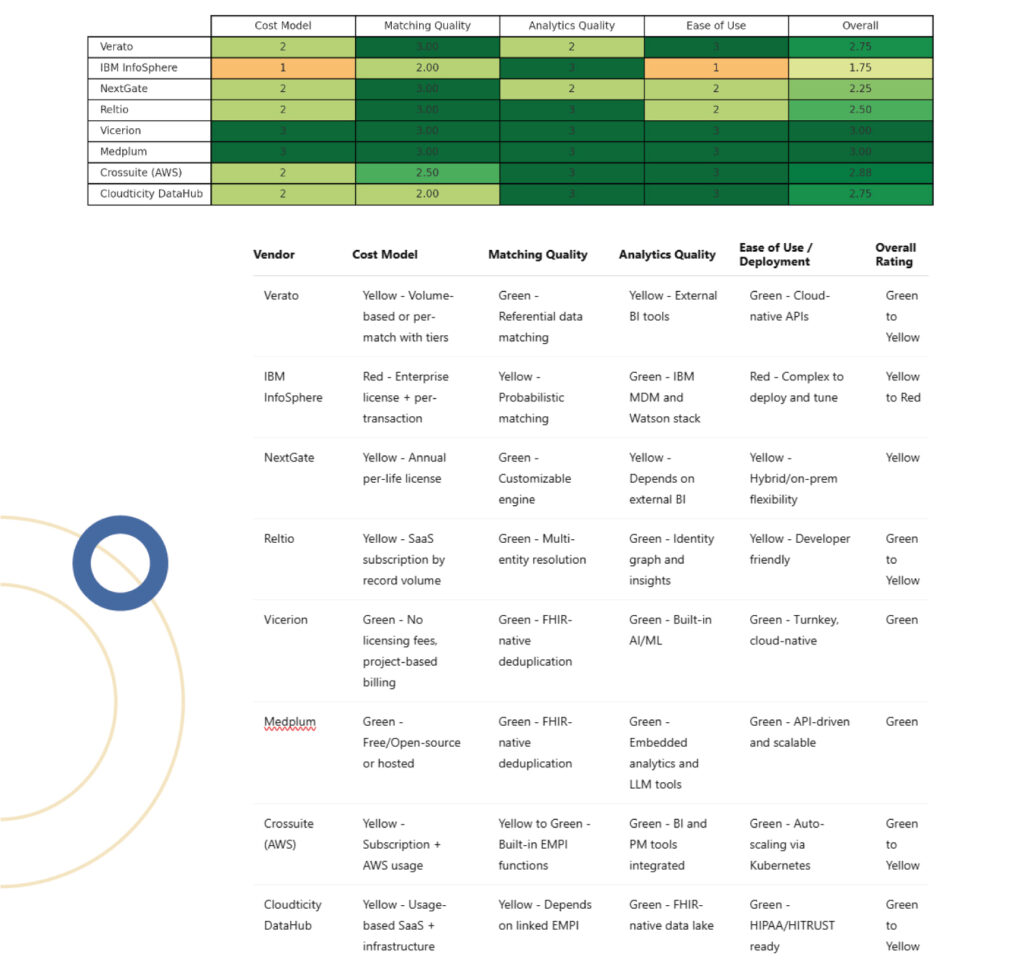Future Proofing Patient Identity
Why FHIR Native, Cloud Native, and Privacy Preserving EMPI Systems Are Redefining Healthcare Interoperability
By Shawna Koch Bronski, RN, MBA
Published: 06/02/2025
Vicerion Corp White Paper
The next generation of Enterprise Master Patient Index (EMPI) systems is here. As healthcare pivots toward real-time interoperability, cross-organizational collaboration, and AI-driven analytics, traditional EMPI tools are struggling to keep pace. Today, the convergence of FHIR-native architectures, cloud-native scalability, and privacy-preserving record linkage (PPRL) is reshaping how health systems unify patient identities. This white paper outlines the critical forces behind these trends, real-world case studies, and an expanded vendor comparison to help stakeholders navigate this transformation.
Executive Summary
FHIR (Fast Healthcare Interoperability Resources) is rapidly becoming the backbone of modern healthcare data exchange. Unlike legacy EMPI systems that require translation layers or custom interfaces, FHIR-native EMPI solutions are built directly on top of the FHIR resource model.
1. The Rise of FHIR-Native EMPI
Benefits:
- Seamless integration with EHRs and APIs
- Event-driven deduplication and real-time updates
- Supports longitudinal record-building across encounters and organizations
Case Example: Vicerion Corp’s Zero-In™ tool uses a real-time de-duplication pipeline powered by FHIR subscriptions. Every new Patient resource is checked for duplicates upon ingestion, reducing duplication rates and syncing identities across platforms like Cerner and Epic. It supports visibility and research for a wound management DME company.
2. Cloud-Native EMPI: Scalability and Efficiency
Healthcare data is growing exponentially, requiring resilient, cost-effective infrastructure. Cloud-native EMPI systems use platforms like AWS, Azure, and GCP for elastic scaling, containerized deployments, and pay-as-you-go billing.
Advantages:
- Auto-scaling infrastructure to meet peak demands
- No upfront server or infrastructure cost
- Built-in HIPAA and GDPR compliance
Case Examples:
- Crossuite migrated its EMPI to AWS EKS, serving 13M patients with 30% cost savings and 99.9% uptime
- Cloudticity DataHub created a FHIR data lake for New York State’s COVID-19 response, reducing integration costs by 90%
3. Privacy-Preserving Record Linkage (PPRL)
HIPAA and GDPR restrict data sharing. PPRL enables patient identity matching across systems without exposing PII.
Core Techniques:
- Tokenization and hashing (e.g., Bloom filters)
- Secure Multi-Party Computation (MPC)
- De-identified linkage with high precision
Case Studies:
- Dell Medical School: Used Datavant’s 44-character tokens to link clinical and social data
- PEDSnet: Used adaptive linkage thresholds for pediatric COVID-19 research
4. Comparative Vendor Analysis
Comparative Vendor Analysis Below is a comprehensive comparison of leading EMPIvendors based on cost, matching quality, analytics integration, and ease of use.

| Vendor | Matching Quality | Cost Efficiency | Analytics Integration | Ease of Use |
| Vicerion | High | Moderate | Advanced | High |
| Vendor A | Medium | High | Moderate | Medium |
| Vendor B | Low | Low | Basic | Low |
| Vendor C | High | High | Advanced | High |
5. Looking Ahead
The healthcare industry must go beyond probabilistic matching and static systems. Organizations adopting FHIR-native, cloud-native, and privacy-preserving EMPI solutions will reduce duplication, unlock powerful analytics, and remain compliant with global data privacy mandates. The future of patient identity is real-time, scalable, and secure.
About Vicerion
Vicerion enables real-time, intelligent healthcare interoperability. With a FHIR-native platform, built-in AI/ML tools, and cloud deployment, Vicerion supports scalable and privacy-compliant EMPI for hospitals, startups, and research institutions.
Contact:
📞 914-552-9898
🌐 vicerion.com
In “Future Proofing Patient Identity”, Shawna Koch Bronski reveals how modern EMPI systems—FHIR-native, cloud-native, and privacy-first—are revolutionizing interoperability. Backed by real-world cases and deep insights, this white paper empowers healthcare leaders to embrace future-ready patient identity management.



















